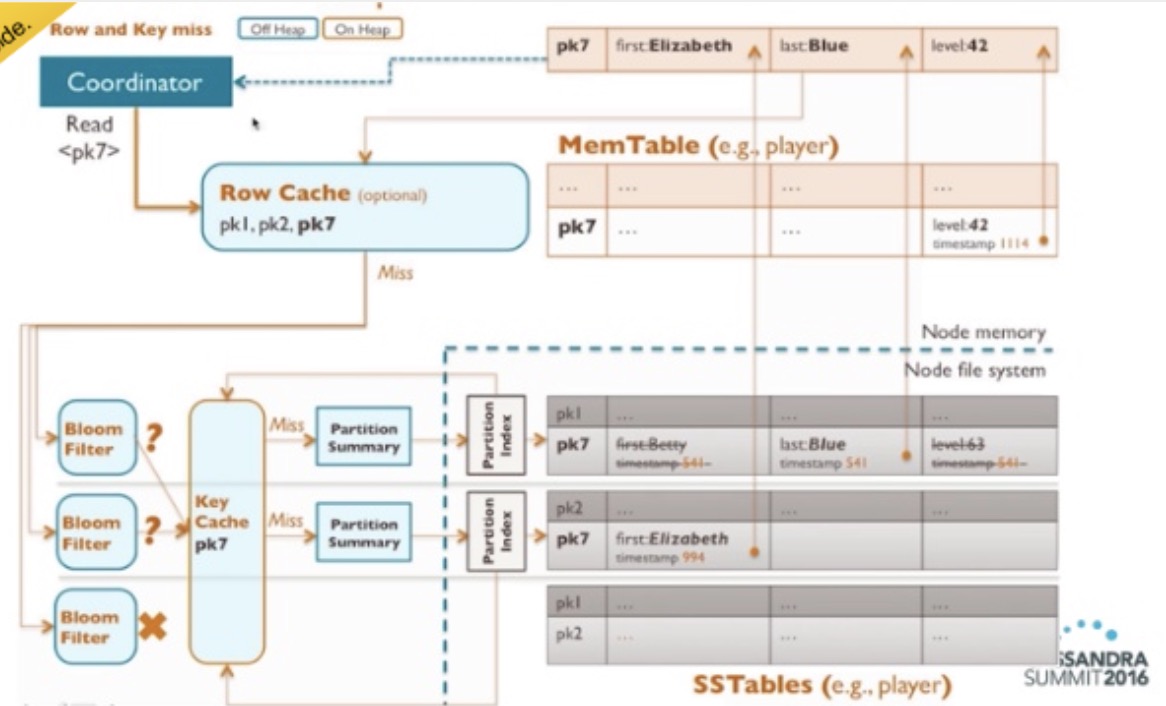Engine
Features
- Consistent hashing
- Replication factor, replicas of the data across the cluster
- Consistency level controlled for each query
- Up to 2 billion key-value pairs in a row

Cassandra replication
- Replication factor = 3
- Consistency level = QUORUM
- Clients talks to any node, the node hashes the partition key and finds the location of the data
- Data is read from all the replicas waiting for responses until we reach a quorum

Cassandra write
- Acknowledged when we write to both the commit log (append only) and the memtable
- When the memtable becomes full it’s flushed into an SSTable
- Periodically SSTables are merged

Cassandra read
- Check if the key is in the in-memory row cache
- Query the bloomfilters of the existing SSTables to find the record, if it doesn’t exist then skip the SSTable
- If the bloomfilter says that there may be data check the in-memory key cache
- On miss get the data from the SSTable and merge it with the data in the memtable, write the key to the in-memory key-cache and merged result to the in-memory row cache
Data modeling
Goals
- spread data evenly around the cluster
- minimize the number of partitions read
- keep partitions manageable
Process
- Identify initial entities and relationships
- Key attributes (map to PK columns)
- Equality search attributes (map to the beginning of the PK)
- Inequality search attributes (map to clustering columns)
- Other attributes
- Static attributes are shared within a given partition
primary key = partition key + clustering columns
Legend:
K Partition key
C Clustering key and their ordering (ascending or descending)
S Static columns, fixed and shared per partition

Cassandra table structure
Validation
- Is data evenly spread?
- 1 partition per read?
- Are writes (overwrites) possible?
- How large are the partitions? Let’s assume that each partition should have at most 1M cells, $n_{cells} = n_{rows} * (n_{cols} - n_{K} - n_{S}) + n_{S} < 1M$
- How much data duplication?
Examples
Store books by ISBN
| Attribute | Special |
|---|---|
| isbn | K |
| title | |
| author | |
| genre | |
| publisher |
- Is data evenly spread? Yes
- 1 partition per read? Yes
- Are writes (overwrites) possible? Yes
- How large are the partitions? $1 * (5 - 1 - 0) + 0 < 1M$
- How much data duplication? 0
Register a user uniquely identified by an email/password, we also want their fullname. They will be accessed by email and password or by UUID
| Attribute | Special |
|---|---|
| K | |
| password | C |
| fullname | |
| uuid |
Q1: find users by login info
Q3: find users by email (to guarantee uniqueness)
- Is data evenly spread? Yes
- 1 partition per read? Yes
- Are writes (overwrites) possible? Yes
- How large are the partitions? $1 * (4 - 1 - 0) + 0 < 1M$
- How much data duplication? 0
| Attribute | Special |
|---|---|
| uuid | K |
| fullname |
Q2: get users by UUID
- Is data evenly spread? Yes
- 1 partition per read? Yes
- Are writes (overwrites) possible? Yes
- How large are the partitions? $1 * (2 - 1 - 0) + 0 < 1M$
- How much data duplication? 0
Find books a logged in user has read sorted by title and author
| Attribute | Special |
|---|---|
| uuid | K |
| title | C |
| author | C |
| fullname | S |
| ISBN | |
| genre | |
| publisher |
- Is data evenly spread? Yes
- 1 partition per read? Yes
- Are writes (overwrites) possible? Yes
- How large are the partitions? (up to 200k book reads per user)
$$
\begin{align*}
n_{books} * (7 - 1 - 1) + 1 & < 1M \\\\
n_{books} & < \frac{1M}{5} - 1 \\\\
n_{books} & < 200k
\end{align*}
$$
- How much data duplication? 0
Interaction of every user in the website
| Attribute | Special |
|---|---|
| uuid | K |
| time | C (desc) |
| element | |
| type |
- Is data evenly spread? Yes
- 1 partition per read? Yes
- Are writes (overwrites) possible? Yes
- How large are the partitions? (up to 333k book reads per user, 333k actions may be low number of actions to store therefore we should store actions by bucket)
$$
\begin{align*}
n_{actions} * (4 - 1 - 0) + 0 & < 1M \\\\
n_{actions} & < 333K
\end{align*}
$$
- How much data duplication? 0
| Attribute | Special |
|---|---|
| uuid | K |
| month | K |
| time | C (desc) |
| element | |
| type |
- Is data evenly spread? Yes
- 1 partition per read? Yes
- Are writes (overwrites) possible? Yes
- How large are the partitions? (up to 333k book reads per user)
1 year = 333k / 365 / 24 = 38 actions / h
1 month = 333k / 30 / 24 = 462 actions / h (most realistic case)
1 week = 333k / 7 / 24 = 1984 actions / h
$$
\begin{align*}
n_{actions} * (5 - 2 - 0) + 0 & < 1M \\\\
n_{actions} & < 333K
\end{align*}
$$
- How much data duplication? 0
References
- https://www.slideshare.net/DataStax/scalable-data-modeling-by-example-carlos-alonso-job-and-talent-cassandra-summit-2016
- https://blog.emumba.com/apache-cassandra-part-5-data-modelling-in-cassandra-9e81a58f4ada
- https://www.datastax.com/blog/2015/02/basic-rules-cassandra-data-modeling
- https://tech.ebayinc.com/engineering/cassandra-data-modeling-best-practices-part-1/
- https://www.datastax.com/sites/default/files/content/whitepaper/files/2019-10/CM2019236%20-%20Data%20Modeling%20in%20Apache%20Cassandra%20%E2%84%A2%20White%20Paper-4.pdf



